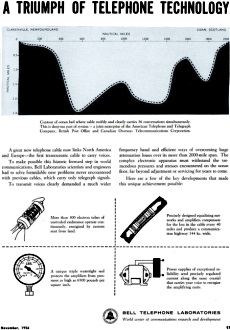Bell Telephone Laboratories - Transatlantic Cable |
||||||
Prior to satellite communications, long-distance messages were carried by footmen, horses and riders, smoke signals, trains, airplanes, boats, lanterns, sign language, printed media, radio frequency, and cables. All had their advantages and disadvantages, but none other than cable could provide reliable, nearly instantaneous conversations across and between continents - or cities for that matter. Stringing wires on poles over the landscape was a relatively simple task compared to that of laying cable along the ocean floor. Maintenance on underwater cable and amplifiers was exceedingly difficult or even impossible in some sections. Developing a suitable insulation to withstand the harsh salt water environment and the extreme pressures at great depths (which tends to force water through insulation) was no trivial task. Deployment came with its own perils for ship, crew, and cable. Breakage during the laying process was common. It was a major victory when AT&T, the British PO and the Canadian OTC managed a 2000-mile transoceanic telephone cable capable of carrying a whopping 36 concurrent conversations, as reported in this 1956 issue of Radio & Television News magazine. Bell Telephone Laboratories Ad - Transatlantic Cable
A great new telephone cable now links North America and Europe - the first transoceanic cable to carry voices. To make possible this historic forward step in world communications, Bell Laboratories scientists and engineers had to solve formidable new problems never encountered with previous cables, which carry only telegraph signals. To transmit voices clearly demanded a much wider frequency band and efficient ways of overcoming huge attenuation losses over its more than 2000-mile span. The complex electronic apparatus must withstand the tremendous pressures and stresses encountered on the ocean floor, far beyond adjustment or servicing for years to come. Here are a few of the key developments that made this unique achievement possible: More than 300 electron tubes of unrivaled endurance operate continuously, energized by current sent from land. A unique triple watertight seal protects the amplifiers from pressures as high as 6500 pounds per square inch. Precisely designed equalizing networks and amplifiers compensate for the loss in the cable every 40 miles and produce a communication highway 144 kc. wide. Power supplies of exceptional reliability send precisely regulated current along the same coaxial that carries your voice to energize the amplifying units. Bell Telephone Laboratories World center of communications research and development
Posted July 27, 2022
|
||||||

